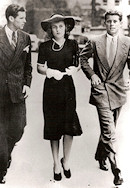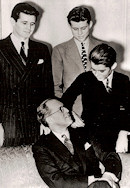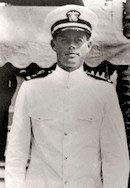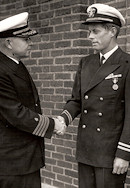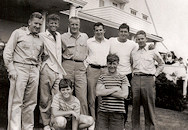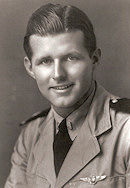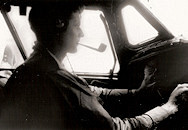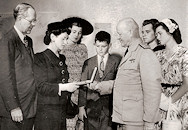![]()

![]()
On the eve of World War II - In London, September 1st, 1939. With the attack by Hitler's armies on Poland that morning, the three most promising Kennedys - Joe Junior, Kathleen and Jack - hurry to attend a special sitting of the British House of Commons.
United States Ambassador to Great Britain, Joseph P. Kennedy, is greeted by a British Bobby. Right - The Ambassador with Joe Junior, JFK and young Robert.
In his early days as ambassador, Joe Kennedy and his charming young family had taken England by storm, becoming enormously popular. However, after the outbreak of war, Ambassador Kennedy sent his family home to escape the bombing in London and publicly expressed doubts about Britain's ability to stand up to Hitler's onslaught, losing popularity, and eventually losing his position as ambassador as well.
In 1941, at age 24, after previous rejections due to a bad back and other health problems, Jack Kennedy was sworn in as an ensign in the U.S. Navy. His influential father had helped both Jack and older brother Joe overcome any health or other obstacles to get in the Navy.
As his first assignment, Ensign Kennedy was assigned to ONI (Office of Naval Intelligence) in Washington and was there during the Japanese attack on Pearl Harbor, December 7, 1941. Ensign Kennedy was abruptly reassigned to a desk job in South Carolina in January 1942, possibly due to a romantic relationship with a Danish woman, Inga Arvad, who had been friendly with high ranking Nazis.
In the South Pacific, Lt. John F. Kennedy at the controls of PT 109. Jack had volunteered in 1942 for PT boat duty while attending officer training in Chicago, then underwent PT boat training in Rhode Island. But his bad back temporarily kept him from getting the combat assignment he wanted. Jack complained he had been 'shafted' and was promptly given the nickname "Shafty."
July 1943 - The crew of PT 109 with their skipper Jack Kennedy (far right). His motorized torpedo (PT) boat was an 80-foot-long plywood vessel powered by 3 engines capable of 40 knots. But the PT boats and their torpedoes were prone to mechanical problems. It was tough, dangerous duty that attracted Ivy League men like Jack with sailing experience, who wanted to command their own small boats.
South Pacific 1943 - In the Solomon Islands the young man used to a life of luxury lived in fairly primitive conditions in a thatched-roof hut while his PT squadron was put in shipshape.
Jack's PT 109 was at first a dirty, bug infested boat in need of repairs. Jack and his crew cleaned and painted the boat while mechanics fixed the engines and hull. PT 109 then went on night training patrols. Returning from patrol, Jack and the others often raced their boats back into the dock. On one occasion, Jack couldn't stop PT 109, crashed into the dock and earned a temporary new nickname, "Crash" Kennedy.
Mid-July 1943, PT 109 was ordered into combat - the mission, to disrupt night-time Japanese supply convoys of ships known as the "Tokyo Express."
Monday, August 2, 1943 - On night patrol, PT 109 was rammed by a Japanese destroyer, killing two of the 13 crewmen. Jack rescued a nearly drowned crewman with bad burns, dragging him out of the water onto the floating hulk. In the process, Jack swallowed a lot of sea water and gasoline and would suffer lifelong stomach problems.
12 hours later they abandoned the wreckage of PT 109 and swam for a nearby island using a makeshift raft built from pieces of the boat. Jack swam while towing the burned crewman for four hours. That night Jack Kennedy swam out with a lantern and a pistol hoping to flag any patrolling PT boats, but was unsuccessful.
They moved to a larger island nearby, with Jack once again towing the injured crewman. Jack made two more attempts to flag PT boats without success. The men lived on coconut milk and rainwater until they eventually made contact with friendly natives. Jack carved a rescue message into a coconut husk which made its way back to the Navy and the crew of PT 109 was rescued by PT boats.
A few weeks later, the story of PT 109 and Jack Kennedy made the front page of The New York Times and Boston papers. Later, flattering accounts appeared in The New Yorker magazine and Reader's Digest.
Jack spent a total of nine months in the South Pacific. After PT 109, he commanded a gunboat, the 59, but saw little combat. He returned to the states, then underwent surgery for his back problems.
June 12, 1944 - The presentation of the Navy and Marine Corps medal for Gallantry in Action to Lt. John F. Kennedy during a simple ceremony at Chelsea Naval hospital in Massachusetts. Jack had also received the Purple Heart. Later in June, he underwent his first back surgery, but would suffer lifelong discomfort.
A reunion in Hyannis Port with PT 109 crew members, September 1944. Left to Right - Red Fay, JFK, L. J. Thom, Jim Reed, Barney Ross, Bernie Lyons, young Teddy kneeling in front with cousin Joe Gargan. Right - A candid snapshot of the Kennedy girls on the porch. Left to right - Kathleen, Pat, Eunice, Jean.
Brother Joe - The Fallen Hero
Joseph P. Kennedy, Jr., the man who would be president. His father dreamed of the day when Joe would become the first Irish Catholic president of the United States.
Joe Junior in 1941 as a Navy pilot in training at the Naval air base at Squantum, Mass., just outside Boston. Joe could have had a job in Navy intelligence, but chose the elite aviation corps instead. Joe got his wings in May of 1942, pinned to his chest by his father.
Sporting a pipe, at the controls of a PB4Y-1 bomber plane. Joe was assigned to England in 1943 where he flew patrols looking for German submarines at sea which were often very hard to spot, leading to a fairly dull tour of duty. In 1944 he signed on for a second tour and in July volunteered for a special attack unit secret mission to knock out Hitler's V-1 rockets.
Project Anvil involved using explosive-filled bombers which were piloted partway to their target, and after the pilot bailed out, were then guided by radio control to smash into German submarine pens or rocket-launching sites. On August 12, Joe Kennedy's plane exploded shortly after takeoff, killing him and his co-pilot instantly. Project Anvil was so secret the Kennedy family was told few details.
U.S. Navy notification letter: Page one Page two
1945 - The Kennedy family, still grieving at the loss of their first child, is presented with the Navy Cross, the highest honor below the Medal of Honor. The loss was devastating to Joe Kennedy Sr. who had so much hope for the future of his beloved namesake. In his absence he turned to his next son, Jack. Shortly after the war ended, John Fitzgerald Kennedy's political career began.
JFK Photo History
Early Years | War Hero | Politician | President
Copyright © 1996-2025 The History Place™ All Rights Reserved
Terms of use: Private home/school non-commercial, non-Internet re-usage only is allowed of any text, graphics, photos, audio clips, other electronic files or materials from The History Place.
|
|
|
|
